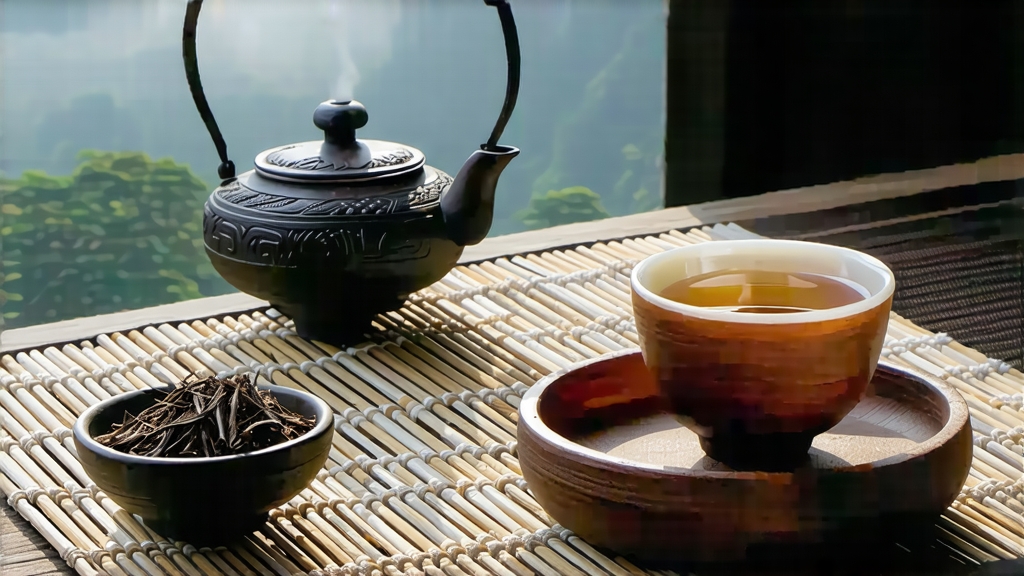
Tucked into the mist-laden folds of southern China’s Guangxi Zhuang Autonomous Region, Liupao tea (often written Liu Bao) is the quiet genius of the dark-tea family. While Pu-erh from Yunnan commands global fame, Liupao has spent four centuries maturing in bamboo baskets, absorbing the humid subtropical air of the Wuzhou region until its leaves glow like burnt mahogany and its liquor tastes of velvet smoke, dried longan, and the faintest echo of betel nut. To understand Liupao is to listen to a tea that speaks in low, gravelly tones about river traders, imperial garrisons, and the slow alchemy of microbes.
Historical footprints
The earliest written record appears in the 1661 edition of the Wuzhou Gazetteer: “Tea from Liupao village, pressed into baskets, travels down the Xun River to Guangzhou and beyond.” Caravan leaders appreciated its ability to suppress miasma and aid digestion on the long haul to Southeast Asia; by the Qing dynasty it was stipulated in imperial edicts as part of the “horse-tea” barter with border troops. In 1886 the British East India Company shipped 1,100 chests of Liupao from Hong Kong to Calcutta, where planters studied its fermentation in vain hopes of replicating it in Assam. Thus Liupao became one of the first Chinese teas to circle the globe, yet it never lost its village accent.
Micro-terroirs within one name
Liupao is not a single garden but a cluster of hamlets—Liupao, Shiqiao, Tangping—scattered on red lateritic soil at 200–500 m elevation. The native cultivar, a large-leaf Camellia sinensis var. assamica locally called “Qunti,” develops leaves as broad as a farmer’s palm. Within the official Liupao protected zone, three substyles are recognised:
- Traditional basket Liupao: leaves steamed, packed into 40 kg bamboo husks, and stacked in riverside warehouses.
- Loose “san cha”: the same leaf allowed to age unpackaged, yielding faster oxidation and a lighter cup.
- Modern compressed bing: 100–500 g cakes pressed since 2003 for the urban collector market, often blended for consistency.
Crafting the darkness
Harvest begins in late April, when two leaves and a bud still wear their spring down. After a brief outdoor withering, the leaves are wok-fired at 280 °C for eight minutes—just enough to kill green enzymes while preserving leaf integrity. The crucial twist is “wan duan,” a 30-minute rolling that bruises cell walls into frayed ribbons. Then comes the Guangxi hallmark: a 12-hour wet-piling phase conducted on cement floors lined with banana leaves. Workers spray 28 °C river water to maintain 85 % humidity, turning the pile every hour so thermophilic microbes (Aspergillus, Blastobotrys, and a local yeast dubbed “Wuzhou No.1”) bloom evenly. Temperature probes are inserted like acupuncture needles; when the core hits 55 °C the pile is dismantled and sun-dried on bamboo mats. Finally the semi-fermented leaf is steamed, rammed into gunny-lined bamboo baskets, and moved to riverside “tea caves”—actually warehouses whose brick walls exhale the perpetual damp of the Xun River. Here the tea will rest for a minimum of three years, often twenty, while seasonal tides rinse the air with moisture and the aroma of camphor trees drifts in through louvered windows.
The art of the basket
Basket construction itself is heritage: two-year-old mao bamboo is split into 1 cm strips, soaked in salt water, then woven into a double-layered husk that breathes better than wood yet keeps the leaf block intact. Every five years the outer husk is replaced, allowing tea masters to inspect the interior “tea brain,” a white bloom of yeasts that looks alarming but smells of honey and old books. Connoisseurs prize the concentric rings that form inside the basket; each ring represents one monsoon cycle and can be peeled off like tree bark to reveal progressively darker leaf.
Tasting time in a cup
For brewing, think of Liupao as a whisky rather than a delicate green. Begin with 6 g of leaf in a 150 ml Yixing clay teapot that has been seasoned only with dark teas. R